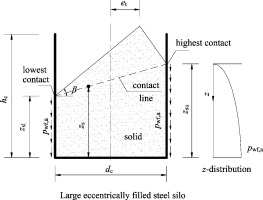当前位置:
X-MOL 学术
›
Powder Technol.
›
论文详情
Our official English website, www.x-mol.net, welcomes your
feedback! (Note: you will need to create a separate account there.)
Buckling design of large eccentrically filled steel silos
Powder Technology ( IF 4.5 ) Pub Date : 2018-03-01 , DOI: 10.1016/j.powtec.2018.01.001 Qing-shuai Cao , Yang Zhao
Powder Technology ( IF 4.5 ) Pub Date : 2018-03-01 , DOI: 10.1016/j.powtec.2018.01.001 Qing-shuai Cao , Yang Zhao

|
Abstract Large steel silos are typical kinds of thin-walled structure which are widely used for storing huge quantities of granular solids in industry and agriculture. In the present analyses, buckling design of circular steel silos subject to large eccentricity filling pressure is demonstrated in accordance with Eurocode: EN1990, 1991, 1993 . The finite element model is established by using the commercial general purpose computer package ANSYS. Five types of buckling analyses are carried out for the geometrically perfect and imperfect models, with and without the consideration of the material plasticity, which are designated as LBA, GNA, GMNA, GNIA, and GMNIA in EN 1993 Part 1–6. Buckling behavior of five example steel silos with capacity of 40,000 to 60,000 m 3 is investigated whose slenderness ranges from 1.89 to 0.46, comprising intermediate slender and squat silos widely applicable in practical engineering. The results show that the buckling deformations are nonsymmetrical and the GMNIA analysis gives out the least buckling load factor for all example silos from all proposed buckling analysis types, and the load displacement curves are highly nonlinear and predict a distinct maximum load followed by a descending path, in which the maximum load is taken as the critical buckling point λ cr for the equilibrium path. The buckling mode in GMNIA analysis takes the form of the well-known elephant-foot deformation at the bottom part of the shell wall, combined with nonsymmetrical waves in meridional direction throughout the whole height of the silo wall due to the distribution of weld imperfection. The geometrical nonlinearity is beneficial while material nonlinearity is strong and detrimental to buckling behavior of example silos. The effect of weld imperfection is also harmful to buckling resistance of silo, which is more serious for relatively slender silos than squat silos. The buckling is mainly governed by the nonuniform distribution of the solid pressure other than other influential factors as the weld imperfection, geometrical and material nonlinearity, compared with the load case of symmetrical filling. The economical design of steel silos can be effectively measured by the economic index called the ratio of capacity to steel consumption (RCS). It is validated that the index RCS increases rapidly with the decrease of silo slenderness, and the storage efficiency of example silos is increased by about 2.1 times with the slenderness varying from 1.89 to 0.46. It also suggests that the eccentricity in filling of steel silo should be reduced as far as possible for improvement of buckling strength of structure under eccentric filling.
中文翻译:

大型偏心填充钢板仓的屈曲设计
摘要 大型钢板仓是一种典型的薄壁结构,在工农业中广泛用于储存大量粒状固体。在目前的分析中,根据欧洲规范:EN1990、1991、1993 证明了承受大偏心填充压力的圆形钢筒仓的屈曲设计。利用商用通用计算机软件包ANSYS建立有限元模型。在考虑和不考虑材料塑性的情况下,对几何上完美和不完美的模型进行了五种类型的屈曲分析,它们在 EN 1993 第 1-6 部分中被指定为 LBA、GNA、GMNA、GNIA 和 GMNIA。研究了容量为 40,000 至 60,000 m 3 的五个示例钢筒仓的屈曲行为,其细长范围为 1.89 至 0.46,包括在实际工程中广泛适用的中间细长和矮筒仓。结果表明,屈曲变形是非对称的,GMNIA 分析给出了所有提出的屈曲分析类型中所有示例筒仓的最小屈曲载荷因子,载荷位移曲线是高度非线性的,并预测了一个明显的最大载荷,然后是下降路径,其中最大载荷被视为平衡路径的临界屈曲点 λcr。GMNIA 分析中的屈曲模式采用壳壁底部众所周知的象足变形的形式,结合由于焊缝缺陷分布而在整个筒仓壁高度上沿子午方向的非对称波。几何非线性是有益的,而材料非线性很强,不利于示例筒仓的屈曲行为。焊缝缺陷的影响对筒仓的抗屈曲性能也有不利影响,对于相对细长的筒仓比矮筒仓更为严重。与对称填充载荷情况相比,屈曲主要受固体压力的不均匀分布控制,而不是焊缝缺陷、几何和材料非线性等其他影响因素。钢筒仓的经济性设计可以用容量与钢材消耗比(RCS)这个经济指标来有效衡量。验证了指标RCS随着筒仓细长度的降低而迅速增加,示例筒仓的存储效率提高了约2。1 倍,细长从 1.89 到 0.46 不等。也提出应尽量减少钢板仓充填偏心,以提高偏心充填下结构的屈曲强度。
更新日期:2018-03-01
中文翻译:

大型偏心填充钢板仓的屈曲设计
摘要 大型钢板仓是一种典型的薄壁结构,在工农业中广泛用于储存大量粒状固体。在目前的分析中,根据欧洲规范:EN1990、1991、1993 证明了承受大偏心填充压力的圆形钢筒仓的屈曲设计。利用商用通用计算机软件包ANSYS建立有限元模型。在考虑和不考虑材料塑性的情况下,对几何上完美和不完美的模型进行了五种类型的屈曲分析,它们在 EN 1993 第 1-6 部分中被指定为 LBA、GNA、GMNA、GNIA 和 GMNIA。研究了容量为 40,000 至 60,000 m 3 的五个示例钢筒仓的屈曲行为,其细长范围为 1.89 至 0.46,包括在实际工程中广泛适用的中间细长和矮筒仓。结果表明,屈曲变形是非对称的,GMNIA 分析给出了所有提出的屈曲分析类型中所有示例筒仓的最小屈曲载荷因子,载荷位移曲线是高度非线性的,并预测了一个明显的最大载荷,然后是下降路径,其中最大载荷被视为平衡路径的临界屈曲点 λcr。GMNIA 分析中的屈曲模式采用壳壁底部众所周知的象足变形的形式,结合由于焊缝缺陷分布而在整个筒仓壁高度上沿子午方向的非对称波。几何非线性是有益的,而材料非线性很强,不利于示例筒仓的屈曲行为。焊缝缺陷的影响对筒仓的抗屈曲性能也有不利影响,对于相对细长的筒仓比矮筒仓更为严重。与对称填充载荷情况相比,屈曲主要受固体压力的不均匀分布控制,而不是焊缝缺陷、几何和材料非线性等其他影响因素。钢筒仓的经济性设计可以用容量与钢材消耗比(RCS)这个经济指标来有效衡量。验证了指标RCS随着筒仓细长度的降低而迅速增加,示例筒仓的存储效率提高了约2。1 倍,细长从 1.89 到 0.46 不等。也提出应尽量减少钢板仓充填偏心,以提高偏心充填下结构的屈曲强度。











































 京公网安备 11010802027423号
京公网安备 11010802027423号